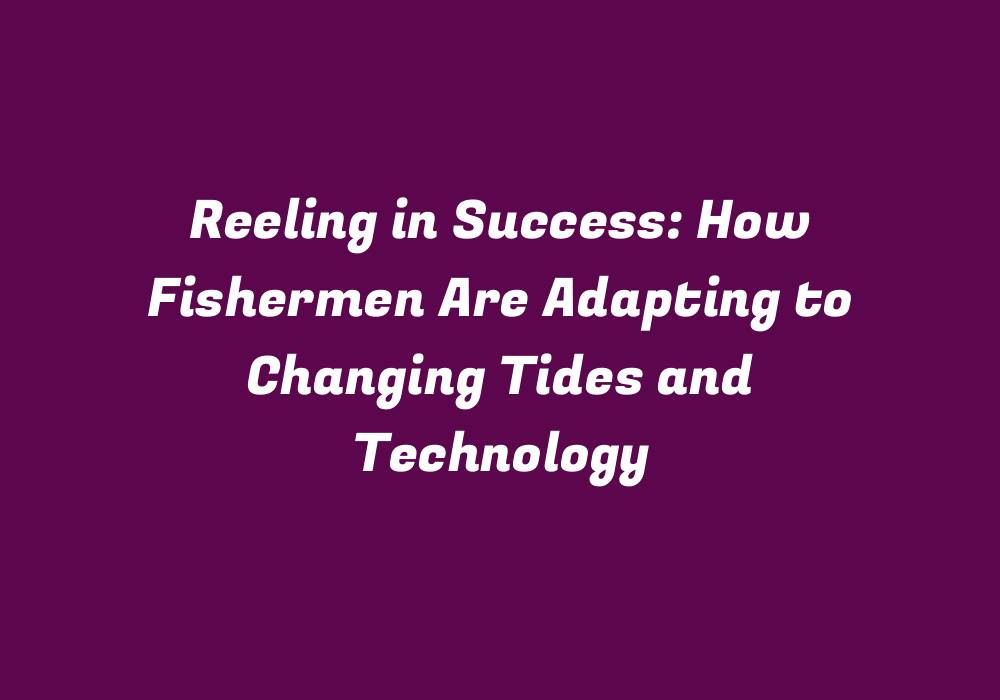Reeling in Success: How Fishermen Are Adapting to Changing Tides and Technology
Introduction
The fishing industry has long been a vital part of the global food system. As technology advances, so do fishermen’s approaches towards sustainability and profitability. This article delves into how modern-day fishermen are adopting various adaptations in response to evolving trends and environmental challenges. By embracing technological advancements, they strive to maintain a delicate balance between tradition and innovation while securing their future in the rapidly changing world of fishing.
Evolution of Traditional Fishing Methods
For centuries, fishermen have relied on various methods like longlines, gillnets, trawls, and hand lines that require minimal technology to catch fish. These practices often leave a significant environmental impact due to bycatch and the destruction of marine habitats. However, these traditional techniques are slowly being replaced or augmented with more sustainable options.
Adaptations for Sustainability
In recent years, there has been an increasing focus on implementing environmentally friendly fishing methods. One notable example is selective gear that specifically targets the desired species, minimizing bycatch and preserving the health of marine ecosystems. Fishermen now also make use of turtle excluder devices to prevent sea turtles from drowning in nets, and fish aggregating devices (FAD) to encourage more efficient catchment while reducing the risk of damaging reef structures.
Technological Advances
Technology has played a transformative role in the fishing industry, enabling fishermen to adapt their practices to better fit with modern needs. For instance, the introduction of sonar devices allows them to locate fish in deeper waters and improve targeting accuracy, thus reducing the need for harmful trawling techniques. Electronic monitoring systems provide real-time data on catches, helping ensure compliance with fishing regulations and promoting transparency within the industry.
Efficiency and Productivity
Innovations have also helped increase fishermen’s efficiency and productivity. The integration of GPS technology into vessels has dramatically improved navigation capabilities, allowing them to reach desired fishing grounds faster. Automated onboard systems are now being implemented to monitor and optimize various aspects of the fishing process, from gear selection to fuel consumption. This not only reduces operational costs but also enhances safety measures for both crews and marine life.
Modern Approaches to Marketing and Distribution
With the rise of e-commerce, fishermen have had to adapt their marketing strategies to reach a wider audience. Social media platforms allow them to directly communicate with consumers about their products, promoting transparency and fostering stronger relationships. This new approach encourages direct sales to customers seeking fresh seafood options or sustainable alternatives.
Fisheries Management and Cooperation
As the industry undergoes significant changes, effective fisheries management is crucial for the long-term success of both the fishing sector and the marine environment. Collaboration between fishers, governments, and non-governmental organizations (NGOs) has become increasingly important to implement sustainable practices, ensure proper regulation enforcement, and protect threatened species from overfishing.
Innovative Techniques for Fishing Gear and Equipment
Innovations in fishing gear design are also playing a key role in promoting sustainability while maintaining high catch rates. For instance, the development of more selective nets that target specific species helps reduce bycatch. Fishing ropes made with biodegradable material minimize their impact on the environment when discarded or lost at sea. Additionally, the use of drones and underwater robots is revolutionizing monitoring activities, allowing for better decision-making and improved resource management.
Future Challenges and Opportunities
As fishermen continue to adapt to technological advancements and environmental concerns, it is essential to anticipate potential challenges. One pressing issue is the need for more efficient methods of fish processing, storage, and transportation to maintain the freshness and quality of their products. Integrating these aspects with modern fishing practices can lead to a more streamlined and sustainable value chain in the fishing industry.
Conclusion
In today’s rapidly changing world, fishermen are adapting their techniques to balance tradition with innovation, sustainability, and technological advancements. Through collaborative efforts, fisheries management reforms, and improvements in fishing gear design, they strive to ensure a sustainable future for the industry while maintaining their livelihoods and the health of marine ecosystems. The success of this transition lies in continuing to embrace new technologies and practices that support environmental conservation, promote public trust in seafood products, and contribute to the long-term viability of fishing communities worldwide.
